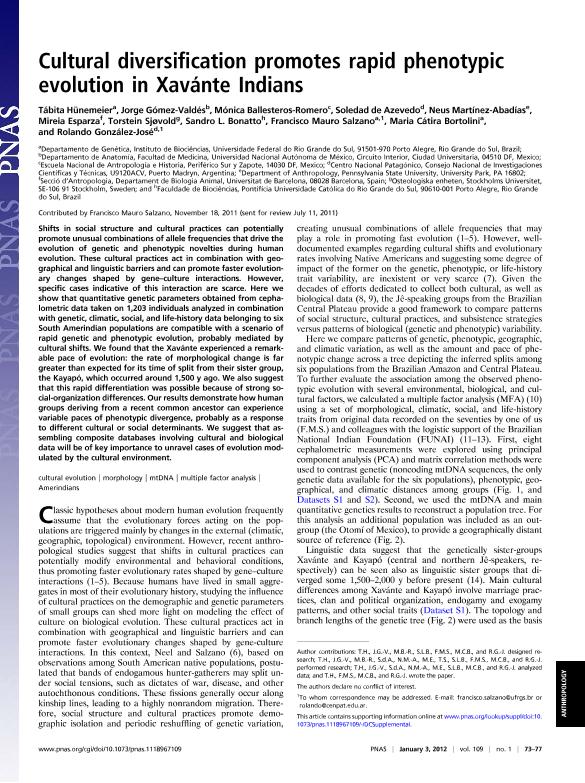Mostrar el registro sencillo del ítem
dc.contributor.author
Hünemeier, Tábita
dc.contributor.author
Gómez Valdés, Jorge
dc.contributor.author
Ballesteros Romero, Mónica
dc.contributor.author
de Azevedo, Soledad

dc.contributor.author
Martínez Abadías, Neus
dc.contributor.author
Esparza, Mireia
dc.contributor.author
Sjøvold,Torstein
dc.contributor.author
Bonatto, Sandro L.
dc.contributor.author
Salzano, Francisco Mauro
dc.contributor.author
Bortolini, Maria Catira

dc.contributor.author
González José, Rolando

dc.date.available
2017-09-15T19:38:45Z
dc.date.issued
2012-01-03
dc.identifier.citation
Hünemeier, Tábita; Gómez Valdés, Jorge; Ballesteros Romero, Mónica; de Azevedo, Soledad; Martínez Abadías, Neus; et al.; Cultural diversification promotes rapid phenotypic evolution in Xavánte Indians; National Academy of Sciences; Proceedings of the National Academy of Sciences of The United States of America; 109; 1; 3-1-2012; 73-77
dc.identifier.issn
0027-8424
dc.identifier.uri
http://hdl.handle.net/11336/24419
dc.description.abstract
Shifts in social structure and cultural practices can potentially promote unusual combinations of allele frequencies that drive the evolution of genetic and phenotypic novelties during human evolution. These cultural practices act in combination with geographical and linguistic barriers and can promote faster evolutionary changes shaped by gene–culture interactions. However, specific cases indicative of this interaction are scarce. Here we show that quantitative genetic parameters obtained from cephalometric data taken on 1,203 individuals analyzed in combination with genetic, climatic, social, and life-history data belonging to six South Amerindian populations are compatible with a scenario of rapid genetic and phenotypic evolution, probably mediated by cultural shifts. We found that the Xavánte experienced a remarkable pace of evolution: the rate of morphological change is far greater than expected for its time of split from their sister group, the Kayapó, which occurred around 1,500 y ago. We also suggest that this rapid differentiation was possible because of strong social-organization differences. Our results demonstrate how human groups deriving from a recent common ancestor can experience variable paces of phenotypic divergence, probably as a response to different cultural or social determinants. We suggest that assembling composite databases involving cultural and biological data will be of key importance to unravel cases of evolution modulated by the cultural environment.
dc.format
application/pdf
dc.language.iso
eng
dc.publisher
National Academy of Sciences

dc.rights
info:eu-repo/semantics/openAccess
dc.rights.uri
https://creativecommons.org/licenses/by-nc-sa/2.5/ar/
dc.subject
Cultural Evolution
dc.subject
Morphology
dc.subject
Mtdna
dc.subject
Multiple Factor Analysis
dc.subject
Amerindians
dc.subject.classification
Bioquímica y Biología Molecular

dc.subject.classification
Ciencias Biológicas

dc.subject.classification
CIENCIAS NATURALES Y EXACTAS

dc.title
Cultural diversification promotes rapid phenotypic evolution in Xavánte Indians
dc.type
info:eu-repo/semantics/article
dc.type
info:ar-repo/semantics/artículo
dc.type
info:eu-repo/semantics/publishedVersion
dc.date.updated
2017-09-07T16:51:31Z
dc.identifier.eissn
1091-6490
dc.journal.volume
109
dc.journal.number
1
dc.journal.pagination
73-77
dc.journal.pais
Estados Unidos

dc.journal.ciudad
Washington D. C.
dc.description.fil
Fil: Hünemeier, Tábita. Universidade Federal do Rio Grande do Sul; Brasil
dc.description.fil
Fil: Gómez Valdés, Jorge. Universidad Nacional Autónoma de México; México
dc.description.fil
Fil: Ballesteros Romero, Mónica. Escuela Nacional de Antropología e Historia; México
dc.description.fil
Fil: de Azevedo, Soledad. Consejo Nacional de Investigaciones Científicas y Técnicas. Centro Científico Tecnológico Conicet - Centro Nacional Patagónico; Argentina
dc.description.fil
Fil: Martínez Abadías, Neus. State University of Pennsylvania; Estados Unidos
dc.description.fil
Fil: Esparza, Mireia. Universidad de Barcelona; España
dc.description.fil
Fil: Sjøvold,Torstein. Stockholms Universitet; Suecia
dc.description.fil
Fil: Bonatto, Sandro L.. Pontificia Universidade Catolica Do Rio Grande Do Sul; Brasil
dc.description.fil
Fil: Salzano, Francisco Mauro. Universidade Federal do Rio Grande do Sul; Brasil
dc.description.fil
Fil: Bortolini, Maria Catira. Universidade Federal do Rio Grande do Sul; Brasil
dc.description.fil
Fil: González José, Rolando. Consejo Nacional de Investigaciones Científicas y Técnicas. Centro Científico Tecnológico Conicet - Centro Nacional Patagónico; Argentina
dc.journal.title
Proceedings of the National Academy of Sciences of The United States of America

dc.relation.alternativeid
info:eu-repo/semantics/altIdentifier/url/http://www.pnas.org/content/109/1/73
dc.relation.alternativeid
info:eu-repo/semantics/altIdentifier/doi/http://dx.doi.org/10.1073/pnas.1118967109
Archivos asociados
